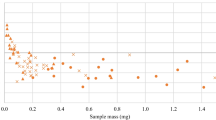Abstract
We report the first spectral photoacoustic measurements of silica, coal, and kaolinite dust absorption coefficients from 11 to 13 μm at 5 nm resolution made with a tunable quantum cascade laser. This is important because airborne silica dust and coal dust within mining environments continue to be a problem for mine workers and staff due to their severe health effects on the respiratory system, while other dust types are potentially interferents to their detection. Our real-time spectra compare favorably with the non-real-time filter-based Fourier transform infrared spectrometer (FTIR) spectra obtained using the sampling system developed by NIOSH for their end-of-shift method to determine silica dust concentrations using a portable FTIR. We discuss our new dust generation system and instrument testing chamber. We also show that our PM4 silica mass concentration measurements by a low-cost air quality sensor (SPS30) are in good agreement with the TSI Aerosol Particle Sizer instrument, the NIOSH end of shift method, gravimetric mass, and correlate well with photoacoustic light absorption measurements at a wavelength where silica absorbs strongly.







Similar content being viewed by others
References
NIOSH: NIOSH hazard review: health effects of occupational exposure to respirable crystalline silica. The National Institute for Occupational Safety and Health; 2002.
Schatzel SJ (2009) Identifying sources of respirable quartz and silica dust in underground coal mines in southern West Virginia, western Virginia, and eastern Kentucky. Int J Coal Geol 78:110–118
Hart JF, Autenrieth DA, Cauda E, Chubb L, Spear TM, Wock S, Rosenthal S (2018) A comparison of respirable crystalline silica concentration measurements using a direct-on-filter Fourier transform infrared (FT-IR) transmission method vs a traditional laboratory X-ray diffraction method. J Occupational Environ Hygiene 15:743–754
Kachuri L, Villeneuve PJ, Parent ME, Johnson KC, Harris SA, Canadian Canc R (2014) Occupational exposure to crystalline silica and the risk of lung cancer in Canadian men. Int J Cancer 135:138–148
Laney AS, Weissman DN (2014) Respiratory diseases caused by coal mine dust. J Occup Environ Med 56:S18–S22
Colinet J, Listak JM, Organiscak JA, Rider JP, Wolfe AL: Best practices for dust control in coal mining. Information circular National Institute for Occupational Safety and Health, Office of Mine Safety and Health Research 2010.
Pampena JD, Cauda EG, Chubb LG, Meadows JJ (2020) Use of the field-based silica monitoring technique in a coal mine: a case study. Mining Metallurgy & Exploration 37:717–726
NIOSH: NIOSH 7603 method. Cincinnati, Ohio: National Institute for Occupational Safety and Health; 2003:1–7.
MSHA: MSHA P7 method. Pittsburgh, PA US: The Mine Safety and Health Administration; 2013.
Wei SJ, Kulkarni P, Zheng LN, Ashley K (2020) Aerosol analysis using quantum cascade laser infrared spectroscopy: application to crystalline silica measurement. J Aerosol Sci 150:13
Marple VA, Rubow KL (1983) An aerosol chamber for instrument evaluation and calibration. Am Ind Hyg Assoc J 44:361–367
Vincent JH (2005) Health-related aerosol measurement: a review of existing sampling criteria and proposals for new ones. J Environ Monit 7:1037–1053
NIOSH: NIOSH 7500 method. Cincinnati, Ohio: National Institute for Occupational Safety and Health; 2003.
NIOSH: NIOSH 0600 method. Cincinnati, OH, USA: The National Institute for Occupational Safety and Health; 1998.
NIOSH: NIOSH field analysis of silica tool manual. NIOSH; 2020.
Arnott WP, Hamasha K, Moosmuller H, Sheridan PJ, Ogren JA (2005) Towards aerosol light-absorption measurements with a 7-wavelength aethalometer: evaluation with a photoacoustic instrument and 3-wavelength nephelometer. Aerosol Sci Technol 39:17–29
Lewis K, Arnott WP, Moosmuller H, Wold CE (2008) Strong spectral variation of biomass smoke light absorption and single scattering albedo observed with a novel dual-wavelength photoacoustic instrument. J Gerontol Ser A Biol Med Sci 113:14
Gyawali M, Arnott WP, Zaveri RA, Song C, Moosmuller H, Liu L, Mishchenko MI, Chen LWA, Green MC, Watson JG, Chow JC (2012) Photoacoustic optical properties at UV, VIS, and near IR wavelengths for laboratory generated and winter time ambient urban aerosols. Atmos Chem Phys 12:2587–2601
Arnott WP, Moosmuller H, Rogers CF, ** TF, Bruch R (1999) Photoacoustic spectrometer for measuring light absorption by aerosol: instrument description. Atmos Environ 33:2845–2852
Wei SJ, Kulkarni P, Ashley K, Zheng LN (2017) Measurement of crystalline silica aerosol using quantum cascade laser-based infrared spectroscopy. Sci Rep 7:8
Bachler P, Meyer J, Dittler A (2019) Characterization of the emission behavior of pulse-jet cleaned filters using a low-cost particulate matter sensor. Gefahrstoffe Reinhalt Luft 79:443–450
Sensirion: SPS30 specification statement. Sensirion; 2020.
Taylor SJ, Nascimento P, Arnott WP, Kocsis K: Real-time photoacoustic instrument for mass concentration measurements of respirable crystal silica dust: theory. To Be Submitted.
Arnott WP, Moosmuller H, Walker JW (2000) Nitrogen dioxide and kerosene-flame soot calibration of photoacoustic instruments for measurement of light absorption by aerosols. Rev Sci Instrum 71:4545–4552
Acknowledgements
We acknowledge the National Institute for Occupational Safety and Health for funding and technical support. We thank Dr. Emanuele Cauda for his assistance with the NIOSH field-based FTIR technique and the FAST software. Finally, we thank Dr. Mohammadreza Elahifard and Dr. Behrooz Abbasi of the UNR’s Mining and Metallurgical Engineering Department for assistance with X-ray crystallography and Raman spectroscopy.
Author information
Authors and Affiliations
Corresponding author
Ethics declarations
Conflict of Interest
The authors declare no competing interests.
Additional information
Publisher’s Note
Springer Nature remains neutral with regard to jurisdictional claims in published maps and institutional affiliations.
We certify that the submission is original work and is not under review at any other publication.
Rights and permissions
Springer Nature or its licensor holds exclusive rights to this article under a publishing agreement with the author(s) or other rightsholder(s); author self-archiving of the accepted manuscript version of this article is solely governed by the terms of such publishing agreement and applicable law.
About this article
Cite this article
Nascimento, P., Taylor, S.J., Arnott, W.P. et al. Development of a Real-Time Respirable Coal Dust and Silica Dust Monitoring Instrument Based on Photoacoustic Spectroscopy. Mining, Metallurgy & Exploration 39, 2237–2245 (2022). https://doi.org/10.1007/s42461-022-00653-6
Received:
Accepted:
Published:
Issue Date:
DOI: https://doi.org/10.1007/s42461-022-00653-6




